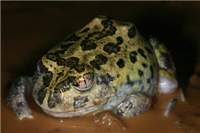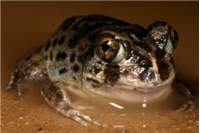Family
Myobatrachidae
Genus
Neobatrachus
Species
sudelli
Threats/Control Methods - Regional
Although N.sudelli is not currently considered at risk, care should be taken at all times when entering frog habitats due to the risk of spreading disease, including the Chytrid fungus (chytridiomycosis). To prevent the spread of the Chytrid fungus it is important to wash your shoes before entering and after leaving frog habitats. For more information on the Chytrid fungus - Link to fact sheet http://www.deh.gov.au/biodiversity/invasive/publications/c-disease/Local/Urban Actions
Although little is known about the ecology of this species, making Frog friendly gardens provides frogs with new habitats, helping to replace those lost through urbanisation. For more information on providing frog habitat in your backyard/schoolyard see Creating a Frog Friendly Habitat in the ACT Community.
Distinguishing Features
Adults may grown up to 4cm in length; colour ranges from grey to yellow to reddish brown; the back skin has an irregular warty texture; the skin around the groin is loose and baggy in appearance as it extends from the side of the body to the knees; pupils are dissected by a vertical slit. Although previously confused with Neobatrachus pictus the two can be distinguished through the presence of 'baggy groin skin' in N. sudelli. The call of the species is a short trill composed of a sequence of soft 'clucks' and 'pops', also described as a "craa-aw-aw-aw-aw-aw-aw-awk".
Common name/s
Common Spadefoot Toad, Spotted Burrowing Frog, Painted Burrowing Frog, Meeowing Frog, Sudell's Frog, Eastern Metal-Eyed Frog
Similar Species
Neobatrachus pictus
Distribution
From southern Queensland extending down into NSW, Victoria and the south-east corner of South Australia.
Country of Origin
Australia
Survey Techniques
The most common technique for monitoring frog populations is based on call identification, with each frog species having a unique call. Frogs should not be handled without the use of sterile gloves, as their skin is very sensitive to chemicals, including detergent and sunscreen.
Conservation (Pet/Pest) Status - National
Currently not thought to be at risk
Conservation (Pet/Pest) Status - Regional
Currently not thought to be at risk
LSCCES Population
In the 2004 Frogwatch survey this species was found in 2% of the sites. The species is not thought to be at risk, although it does seem to have lower populations in areas with improved pastures.
Associated Vegetation Community
Invasive weeds, loss of habitat and urbanisation are all processes detrimental to the species.
Limiting Resources
Woodlands, shrublands and grasslands. Favours swamp type environments including farm dams.
Breeding
This species may be heard calling at anytime of the year, but only after periods of wet weather. Eggs are laid in clumps near aquatic vegetation or the surface of the water.
Behaviour
The adults of the species spend much of their time underground living in burrows, usually only emerging after prolonged periods of rain when the ground is soaked. Males call while floating in water.
Functional Group
Insectivorous
Food Species
Small insects.
Predators
May include native birds, such as the White-Faced Heron (Egretta novaehollandiae) and Intermediate Egret, and fish, including the introduced Carp, Goldfish and Trout. Introduced species such as cats (Felis catus) and foxes may also predate on frogs.
Interesting Fact
N. sudelli possesses a sharp spine on the under surface of their feet, in order to aid in digging.
References - (reader suitability of references, P=Primary teachers, S=Secondary students, T=Tertiary students and researchers)
Books:
Barker, J., Grigg,G., Tyler, M. (1995). A Field Guide to Australian Frogs. Surry Beatty & Sons. NSW, Australia. S, TLintermans,M. & Osborne, W. (2002). Wet & Wild: A Field Guide to the Freshwater Animals of the Southern Tablelands and High Country of the ACT and NSW. Environment ACT. Canberra, Australia. S, TRobinson, M. (1993). A Field Guide to Frogs of Australia. Australian Museum/Reed books. NSW, Australia. S, TTurner, J. (2004). Frogs of Australia. Pensoft. Bulgaria. P, STyler, J. (1994). Australian Frogs: A Natural History. Reed New Holland. Australia. S, TSwan, G.(2001). Green Guide: Frogs of Australia. New Holland Publishers. Sydney, Australia. P, S
Online Publications:
Amphibian Research Centre. (2005). Available Online: http://frogs.org.au/frogs/species/Neobatrachus/sudelli/ S, TAustralian Frogs Database (2005). Neobatrachus sudelli. Available Online: http://frogsaustralia.net.au/frogs/display.cfm?frog_id=190 S, TDepartment of Environment and Heritage, (2004) Chytridiomycosis Factsheet http://www.deh.gov.au/biodiversity/invasive/publications/c-disease/ S, TEnvironment ACT. (2004). Summary of results. Available online: http://www.environment.act.gov.au/Files/frogwatchoctober2004summary.pdf P, S, TEnvironment ACT. (2004). Neobatrachus sudelli; Spotted Burrowing Frog. Available online: http://www.environment.act.gov.au/Files/frogwatchoctober2004-neobatrachussudelliresults.pdf S, TZoological Parks and Gardens Board. Frog Pond Checklist. Available Online: http://www.zoo.org.au/education/factsheets/amp-frog_pond_checklist.pdf P, S, TSpeare, R et al (1998). HOW TO REDUCE THE RISKS OF YOU TRANSMITTING AN INFECTIOUS AGENT BETWEEN FROGS AND BETWEEN SITES. Available Online: http://www.jcu.edu.au/school/phtm/PHTM/frogs/prevent.htm S, TZoological Parks Board N>S>W. (2005.). ASX Frog Focus. Available online: http://www.asxfrogfocus.com/ P, S (School activity program)
Researcher: Pippa Jaminon



 Top
Top Top
Top